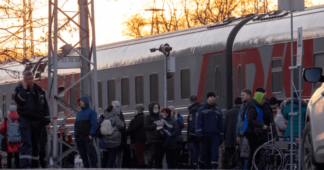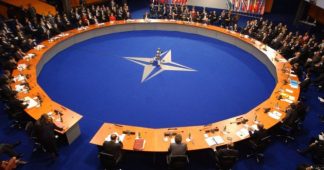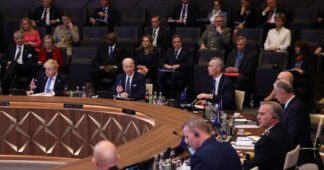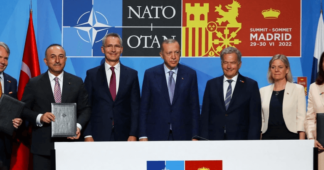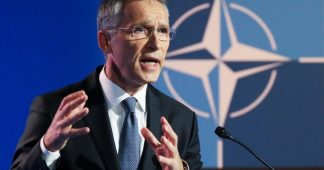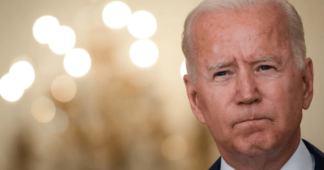by Herman Michiel
17 January 2021
Maybe you quickly scrolled the news that the European Union (EU) and NATO declared on 10 January to “deepen their partnership”. For some, this is only natural now that both organisations are working closely together in their military support to Ukraine; for others, it reaffirms that the EU is a – possibly too – loyal Atlantic ally that must regularly renew its ‘baptismal promises’ to Washington. So, nothing much more than some media show as is the custom with such institutions: big words, ‘historic’ photo, NATO Secretary-General Stoltenberg, Council President Michel and Commission President von der Leyen dutifully holding hands. Most media gave little reason to see more than a fait divers in this, confirming that “the European Union and NATO have decided to take their cooperation to the next level.”
No last-minute improvisation
As so often, such media reports are not incorrect, but neither are they very relevant. Why this display? Why now? Why was the creation of an EU-NATO working group ‘on enhanced protection of critical infrastructure’ announced only a day later? One thing is certain: the 10 January joint statement is not a last-minute improvisation but the result of perhaps two years of busy secret transatlantic talks, i.e. even before Putin’s invasion. Witness a document from the College of Europe. There, we read that in September 2021, work was under way to draft a joint EU-NATO declaration, which was expected to be presented by the end of that year. That did not happen, but it was supposed to be for ‘early 2022’. That too was not the case, and now the next occasion was the major NATO summit in Madrid in June 2022. Again nope, and no declaration by the end of 2022 either. So it became 10 January 2023.
All this suggests that the drafting of the declaration was not plain sailing. Since NATO has been essentially an extension of US foreign and military policy since its inception, it is obvious that the talks were mostly between Brussels and Washington, with the NATO secretary-general as the go-between. Indeed, some friction has developed between the two Atlantic ‘partners’ in recent years, and within the EU itself the violins are not quite evenly matched when it comes to NATO. So an EU-NATO declaration is actually also an EU-NATO-US declaration.
There are sporadic echoes in the media about the background. The New York Times, for example, knows that “negotiations were long and arduous, with sensitive items ranging from European strategic autonomy to the relationship with China.” Politico writes that the statement comes “after months of delay” and that it underlines that there are “limits to cooperation”. It also refers to the tense relationship between NATO member Turkey and several European countries, and Washington’s leading role in the Atlantic alliance. But it is mainly from the initiatives and publications of the influential US think tanks, advising government and Congress – RAND, Brookings, Carnegie Endowment for Peace, Heritage Foundation, Cato and so on – that it becomes clear how closely the European scene is followed in Washington.
The exact facts of the EU-NATO-US triangular relationship can only be speculated on. However, we can identify the main themes that may determine that relation. It will hopefully give us a better understanding of future developments.
Afghanistan
Washington’s unilaterally decided withdrawal of US troops from Afghanistan in August 2021 presented its European ‘partners’, who had conformed to US Afghanistan policy for 20 years, with a fait accompli. Even from the mouth of European Council President Michel, it sounded rather bitsy in early September 2021: “Many people wonder what the 20 years of international presence was good for, and they pointed out the imbalance between Europe’s participation in the international effort in Afghanistan, and the limited influence over the strategic choices and the conduct of affairs as we experienced it in the last days.” One recalls the images of those “last days” with the chaos at Kabul airport, with European military, diplomats and their Afghan interpreters trying to get out of the country as quick as possible. The upset in Europe was all the greater because the decision was made not by the ‘unaccountable’ Trump, but by his ‘distinguished’ successor Biden.
AUKUS
US troops had not been out of Kabul for a fortnight or the European ‘partners’ had to suffer another blow. On 15 September 2021, the United States, Britain and Australia announced their AUKUS initiative: an anti-China ‘Anglo-Saxon’ alliance that the EU was completely excluded from. But much worse than that, by all accounts, for French President Macron and the French arms industry: a mega-contract (€50 billion…) to supply 12 French submarines to Australia was cancelled, and replaced by a contract for British-American nuclear powered submarines. “Macron had apparently not minded that the leaders of the US, Britain and Australia had set themselves apart a few months before, on the margins of the G7 in June 2021,” scowled the Financial Times (24.09.21). One could not laugh at it in Paris, however. French foreign minister Le Drian spoke of a “dagger in the back”, ambassadors were recalled from Washington and Canberra, something far from commonplace among Western ‘partners’.
The US and Eastern Europe
However, not all EU governments reacted equally outraged by the ‘dagger strike’, and one can suspect that there was even some Schadenfreude on the part of some. Already in the early 1990s, after the collapse of the Soviet Union, Poland, Hungary, the Czech Republic and Slovakia (the Visegrad group) were oriented towards the US led NATO, Washington being Moscow’s historical adversary. Even after they became members of the European Union, the United States were able to develop bilateral relations with them, where they found more enthusiastic responses to military initiatives (and offers for arms supplies) than within ‘Old Europe’ (in the words of Bush’s defence secretary Donald Rumsfeld). Especially since the Russian invasion of Ukraine, the ‘New Europe’, Poland in the lead, plays an important role in determining EU-Russia relations, and gives Washington an additional grip on European foreign policy.
Brexit
Another entry point for Washington into European foreign and military policy has traditionally been Britain. One recalls how enthusiastically Tony Blair followed the Americans in attacking Iraq in 2003, while the Franco-German ‘European engine’ stayed explicitly out of it. It is also well known that London provided other services to its big Anglo-Saxon brother, among other things through a UK based branch of the NSA, the sophisticated US electronic spy stronghold that even tapped Angela Merkel’s phone.
Brexit, however, carried the risk for Washington and NATO that it would weaken the US grip on the Atlantic alliance in Europe, and strengthen the role of ‘Gaullist’ France. The strategists at the RAND Corporation devoted an extensive study to it [1], from which the following telling quote about ‘European efforts for a strategic autonomy’:
France, Germany and the UK have remained the countries with the most effective military capabilities in Europe, and have taken the leadership of European defence organisation, initiatives and projects. The three countries are operating as the Europe defence triumvirate and have been nicknamed the ED3. Despite the UK’s exit from the EU, the three countries have remained aligned on the fact that they are stronger together. Along with the inclusion of the UK in the ED3, the European strategic autonomy has also developed in a way that is complementary with NATO, with good coordination between both organisations. Outcomes The UK’s presence in the ED3 has reassured Washington that European strategic autonomy will develop in ways that complement NATO and preserve transatlantic cohesion, but Paris and Berlin retain doubts about the UK’s divided priorities and the special relationship
IRA
IRA here does not stand for the Irish Republican Army of old, but for the ‘Inflation Reduction Act’, a legislative initiative by Joe Biden approved in mid-August 2022. It aims to boost the US economy through climate investments, lower prices (including on medicines), and some tax reform. It is partly reminiscent of EU initiatives like the European Covid Recovery and Resilience Facility (RRF), with the mobilisation of roughly the same amount of money (RRF: €750 billion in grants and loans, IRA: $750 billion). But Biden’s IRA does not care about the ‘fair competition’ and ‘level playing field’ so lauded in Europe, and goes full-on Buy America. For example, an electric car can get up to $7500 in subsidies, but on condition that it was manufactured in the United States. European carmakers feel threatened, and the European Commission fears companies will move out of Europe to enjoy the US manna across the ocean. European protests have so far failed to achieve much, and it is yet another frustration for the superpower ambitions of European leaders. Just two years ago, they received a threatening letter from the Pentagon threatening sanctions if US arms companies could not benefit from the European Defence Fund….
Nordstream
It is doubtful we will soon know how the already mentioned EU-NATO working group ‘on enhanced protection of critical infrastructure’ came about. The statement of 10 January contains so little concrete that the announcement of a joint working group would not have looked bad. But that only happened in a separate statement the following day, proposed by Stoltenberg and von der Leyen alone, without Michel, the member state representative. Of course, ‘protection of critical infrastructure’ is a code word for the sabotage of the Nord Stream pipeline, a subject shrouded in demure silence and secrecy in European headquarters. While all evidence points towards Washington as the executor, co-executor, principal or helper of this ‘industrial terrorism’, with the full knowledge of NATO’s highest circles, the EU declared to do something about it … together with NATO. One could surmise that Paris, Berlin and some other capitals found this a bit too far going, inciting Michel to keep his distance.
China
As already mentioned in the section on AUKUS, the United States is taking an increasingly aggressive stance towards China, but the AUKUS alliance they made to that end did not involve the EU. There are different hypotheses about this. According to some, the US wants the EU to deal with the ‘side issue’ Russia, while it prefers to plan the more serious work – China – without interference. Or perhaps, Washington does not want the disagreements among ‘partners’ that would most likely transpire if it were to come to armed action (for example, around Taiwan) to come out too ostentatiously. The US’ low opinion of European military potential may also play a part. But it could also be that the exclusion is only temporary, waiting a bit until the outrage over the ‘submarine coup’ has subsided. In that case, the EU (after the end of the war in Ukraine?) could be asked to join the AUKUS party afterwards. Will the EU go along with that? Not sure, but observers point out that the 10 January statement mentions Chinese ‘growing assertiveness’ for the first time. The term ‘assertiveness’ is no doubt a compromise, as not all European partners in the Atlantic alliance are out for a collision course with China. Hungary, for instance, signed a cooperation agreement with Beijing just a few months ago, and German businessmen are already warning of the consequences of an anti-China course, which the Greens in particular are pushing for.
The future of ‘strategic autonomy’
China could thus well become the touchstone indicating the direction of EU foreign policy. Officially, it is now pursuing ‘strategic autonomy’, as the von der Leyen Commission announced when it took office, and which also seems to be the wish of French President Macron. But how realistic is this dream of part of the EU elite? We already touched on how in numerous dossiers there are disagreements between member states, making it unlikely that the EU can put itself on the map as a geostrategic superpower. Indeed, how much is left of Europe’s strategic autonomy when there are attacks on infrastructure on its territory that it cannot/may not even investigate? What superpower would allow nuclear missiles to be deployed on its territory (in Belgium, the Netherlands, Germany and Italy) over which only a foreign power has control? Where some of the member states have more ear for that foreign power than for their own headquarters? And where a foreign power installs secret torture chambers without causing a diplomatic uproar?
It is also unlikely that the EU as a union of 27 member states will become a geostrategic global player, a superpower, if it has to decide unanimously among 27 governments on every major issue. However, there is another possibility, which was also prudently provided for in the European treaties: alliances on specific domains of a limited number of member states in a ‘permanent structured cooperation’, known as PESCO. In this way, unanimity is avoided, but access to European money pots and institutions remains open. PESCO is already being used in many military initiatives. An additional ‘advantage’, among others, is that the European Parliament is completely outside the PESCO process.
Outlook?
From what precedes it does become clear that it is precarious to make forecasts about the evolution of the EU in the period ahead. More choices are imposing themselves in an increasingly conflict-ridden world, which can only increase discord within the ‘Union’. Until now, the ‘Old Europe’ had the upper hand within the EU, but the war in Ukraine also showed an increasing role of the ‘New Europe’, which along with Britain often orients itself towards Washington’s ‘strategic hegemony’. But even within ‘Old Europe’, and even more so within the ‘Franco-German tandem’, the ‘engine of European integration’, unanimity often appears very low. The most ambitious military cooperation project within the EU is FCAS, the ‘weapons system of the future’ based on ‘sixth-generation combat aircraft’, swarms of drones and support from space. Whether it will get there (we hope not, of course) is not so certain, as Franco-German industrial cooperation (Airbus-Dassault) comes up against economic competition between the two groups and states, which is actually to be expected in a Union based precisely on economic competition. In other areas, too, the two drivers of the tandem appear to want to go down different paths, making the course of such a vehicle rather uncertain.
And for the left?
One possible conclusion from all this could be that the EU should remove all obstacles that prevent it from becoming a true superpower: abolishing the unanimity rule, genuine integration of the 27 national armies, emancipation vis-à-vis the US ‘mother-in-law’, the promotion of its own military-industrial complex, and so on. Aspects of such option are found not only among right-wing parties and ideologues, but also among more progressive ‘Europeanists’, social democrats, Greens, and also some radical leftists. German politician Oskar Lafontaine, co-founder of die Linke, in a recent essay tellingly titled, Ami, it’s time to go, defends the idea of a ‘European NATO’, not dominated by Washington.
We hope to bring you a critical analysis of this position soon.
[1] RAND Corporation, European Strategic Autonomy in Defence:Transatlantic visions and implications for NATO, US and EU relations, 2021, PDF here,. (The quote is on page 66).
*** Translated with www.DeepL.com/Translator (free version) ***
We remind our readers that publication of articles on our site does not mean that we agree with what is written. Our policy is to publish anything which we consider of interest, so as to assist our readers in forming their opinions. Sometimes we even publish articles with which we totally disagree, since we believe it is important for our readers to be informed on as wide a spectrum of views as possible.
